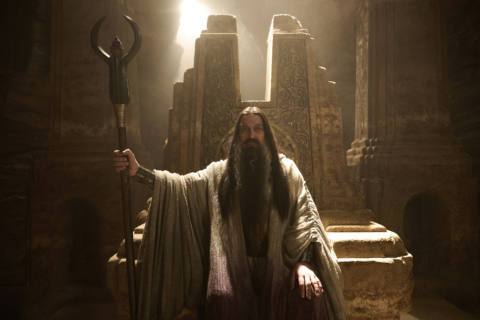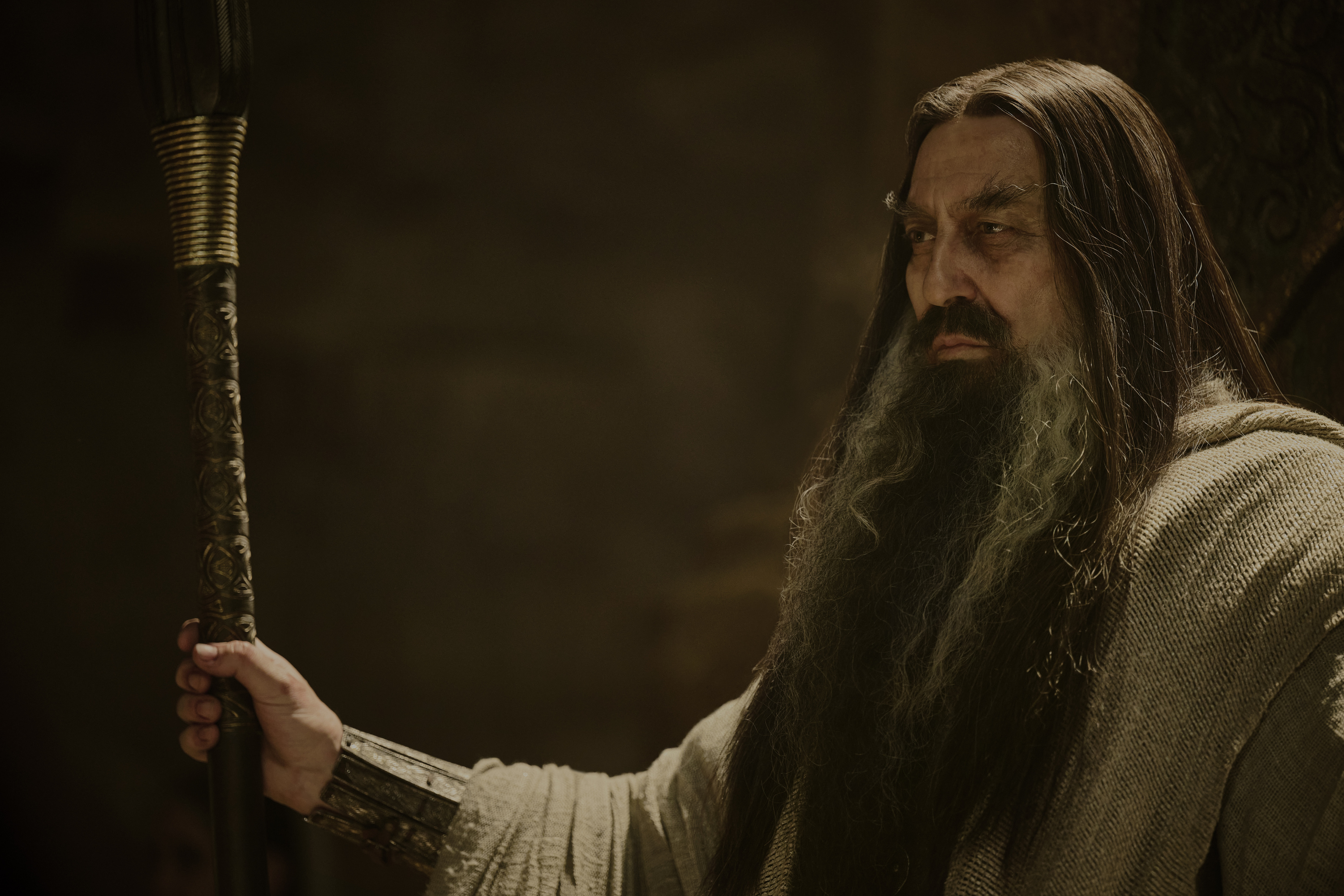
The first season of The Lord of the Rings: The Rings of Power loved its mysteries — a secret Sauron, a spooky sword, and an amnesiac meteor man. And while we had a pretty good idea of who that meteor man was at the end of season 1, the finale of season 2 finally gives him a name.
Showrunners J.D. Payne and Patrick McKay couldn’t let viewers have all the answers, though — and they’ve pulled the clever trick of naming one unknown wizard while teasing another unnamed one at the same time.
[Ed. note: This piece contains spoilers for The Lord of the Rings: The Rings of Power through the finale of season 2.]

This week’s episode caps off the season in multiple ways, including with the anticipated confrontation between the Stranger and the Dark Wizard. The Dark Wizard offers the Stranger a chance to recover his name, his past, and his staff, if only he’ll turn to the Dark Side — I mean, if only he’ll join the Dark Wizard in his quest to defeat Sauron, and then supplant him as Dark Lord. Once the Stranger saw through the Dark Wizard’s attempts to put a kindly face on his true nature, the Wizard blasted a hillside apart and made his exit, leaving the Stoors without a home.
Luckily, Nori and Poppy are on hand to teach the Stoors the traveling way of the Harfoots, and after a few farewells from the newly migratory hobbits — calling the Stranger “Grand Elf” — the Stranger has a new name: Gandalf.
Is that really how Gandalf got his name?
No, but it’s not that far off. See, Tolkien didn’t invent the name “Gandalf” — he cribbed it from somewhere else. Gandalf first appears in The Hobbit, which Tolkien wrote as a tale for children (initially directly as bedtime stories improvised for his own sons and daughter). The writer didn’t conceive of rooting The Hobbit into his Middle-earth lore and languages until he was nearly halfway done with the draft that became The Fellowship of the Ring, years after The Hobbit had been published.
Instead of being rooted in one of Tolkien’s constructed languages, Gandalf and all the dwarves in The Hobbit were cheekily named after dwarven characters mentioned in a section of the Völuspá, a collection of anonymously authored poems essential to the study of the Old Norse language — that is, essential to Tolkien’s own academic concentration. Gandalf, Thorin, Fili and Kili, Bifur, Bofur, Bombur, and even Durin, the name of all of Moria’s kings, come straight from the Poetic Edda.
While “Gandalf” isn’t derived from any of Tolkien’s fictional languages, the roots of the word gandalfr basically mean “cane-elf” in Old Norse — which isn’t so bad of a derivation for a guy who is ageless like elves and wields a staff. Gandalf was what the wizard was called in most human and hobbit languages in Northwestern Middle-earth, though in Gondor, the most elf-adjacent human nation in The Lord of the Rings, he was called by his Sindarin elven name, Mithrandir.
In The Two Towers, Faramir recalls Gandalf telling him about a whole slew of names:
Many are my names in many countries. Mithrandir among the Elves [meaning “Grey Pilgrim/Wanderer”], Tharkûn to the Dwarves [Staff-man]; Olórin I was in my youth in the West that is forgotten [his original name, probably meaning something to do with dreams/vision/the mind], in the South Incánus [Tolkien changed his mind about the meaning of this one a bunch of times], in the North Gandalf; to the East I go not.
Suffice to say: Gandalf has found one of his names, but there’s lots more for The Rings of Power to pick from if it wants to.
So is the Dark Wizard Saruman?

Maybe?
The Dark Wizard confirmed here that he was one of the Istari, or wizards, that the Valar sent to help the peoples of Middle-earth oppose Sauron. But just because he seems like an evil wizard, doesn’t mean he’s The Lord of the Rings’ most prominent evil wizard.
It’s true, in Tolkien’s lore, that Saruman was always jealous of his Istari peers, particularly Gandalf, and resolved early on to grow his own power until he could locate the One Ring, seize it for himself, and supplant Sauron, much in the way The Rings of Power’s Dark Wizard wishes to do.
But Saruman kept all of that so totally secret that even in the time of the War of the Ring, Gandalf openly considered him “the greatest of my order,” and trusted that Saruman’s hard-won knowledge of Ring lore was being wielded for the forces of good.
Saruman seemed to be a good guy to Gandalf, Elrond, Galadriel, and everybody else who knew him, right up until he locked Gandalf up in Orthanc in The Fellowship of the Ring. That doesn’t seem consistent with this Dark Wizard, who just out-and-out tried to kill a whole village of hobbits in front of Gandalf. Perhaps there’s a redemption arc in his future, but it’s hard to think of one that would be that convincing.
What’s more likely is that the Dark Wizard, despite his monochromatic robes, is one of the “Blue Wizards.” In this episode, he confirmed that five Istari were sent to Middle-earth to oppose Sauron, and from Tolkien’s writings, we know exactly who those five wizards are: Gandalf the Grey, Saruman the White, Radagast the Brown, and the two Blue Wizards, as they are now called.
The Blue Wizards exist because of a line Tolkien gave Saruman in The Two Towers, when, sarcastically, the cornered wizard protested against Gandalf’s promise to give him back his staff later, based on good behavior. “Later! Later! Yes, when you also have the Keys of Barad-dûr itself, I suppose; and the crowns of seven kings, and the rods of the Five Wizards, and have purchased yourself a pair of boots many sizes larger than those that you wear now.”
Tolkien did not come back to the question of the remaining wizards until after The Lord of the Rings was fully published. As he wrote to a fan asking about “the other two” in 1958, “I really do not know anything clearly about the other two – since they do not concern the history of the [North West of Middle-earth].” In later writings that were only published after his death, he gave the wizards a color (blue) and said that they went into the far off parts of Middle-earth and never returned to the principal locations of his saga.
Being so unenumerated by Tolkien, these final two Blue Wizards are ripe for The Lord of the Rings: The Rings of Power to expand on in its next seasons. But that’s not all. The Rings of Power can only put what’s in the text of the Lord of the Rings books themselves on the screen — and in The Lord of the Rings, Tolkien never gave the last two wizards a color. That means that even though he’s not wearing blue at all, the Dark Wizard could actually be a Blue Wizard. And the appearance of a Saruman, wisest and best of wizards, could still be on the horizon.
